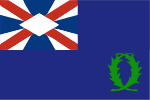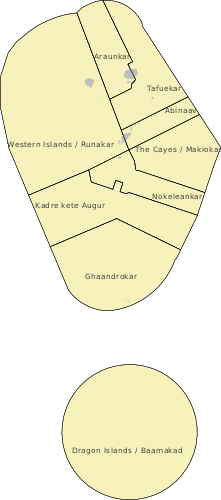Maka: Difference between revisions
No edit summary |
|||
| Line 34: | Line 34: | ||
'''Largest Settlements: Paasoa, Lannref''' | '''Largest Settlements: Paasoa, Lannref''' | ||
Composed of the island Nokelean and a small number of low-lying islands to the north, Nokeleankar is the most populated municipality outside of Tafue. Like Endeburg in Iscu, Lannref, the largest village and municipal seat, was founded by Lentians as part of their trading network, but was never officially a Lentian colony or possession. Paasoa, the oldest village on the island, dates back to the pre-contact period and retains much of the original building styles of the period, including a remarkable town hall.<ref>Nokeleankar Municipal Government (2020) ''Nokeleankar - overview,'' Available at: ''<nowiki>https://www.maka.nokeleankar.mk</nowiki>'' (Accessed: 2022).</ref> The island was developed substantially by a few Ingerish agricultural interests in the 1800s, and most of the original forests were cut down in favor of large orchards, which are now operated | Composed of the island Nokelean and a small number of low-lying islands to the north, Nokeleankar is the most populated municipality outside of Tafue. Like Endeburg in Iscu, Lannref, the largest village and municipal seat, was founded by Lentians as part of their trading network, but was never officially a Lentian colony or possession. Paasoa, the oldest village on the island, dates back to the pre-contact period and retains much of the original building styles of the period, including a remarkable town hall.<ref>Nokeleankar Municipal Government (2020) ''Nokeleankar - overview,'' Available at: ''<nowiki>https://www.maka.nokeleankar.mk</nowiki>'' (Accessed: 2022).</ref> The island was developed substantially by a few Ingerish agricultural interests in the 1800s, and most of the original forests were cut down in favor of large industrial orchards, which are now mainly operated by Enluna Inc, a multi-national firm operating out of Khaiwoon, whose practices on Nokelean have been criticized by locals as exploitative.<ref>Fores, S.A (2014) ''Enluna: Island Exploiter,'' Available at: ''<nowiki>https://www.khaiwoonsentinel.com/plurinesia/2014/enluna-exploiter</nowiki>'' (Accessed: 2022).</ref> | ||
Despite the widespread deforestation, a remarkable amount of diversity remains in the natural environment. Some of the only mangrove habitat in Maka remains on Nokelean, but is in danger from the fish farms that have replaced most of its original coverage area. In addition, on the southern coast lie the Koleanalenna Dunes, which are protected as a nature reserve and see some of the highest visitation rates in the southern cayes by migratory birds, making it a little-known haven for bird-watchers. <ref>Ooma, D (2019) ''Natural Landscapes of Maka's Southern Islands'', 3rd edn., Suvuma: Royal Suvuman Publishers.</ref> | Despite the widespread deforestation, a remarkable amount of diversity remains in the natural environment. Some of the only mangrove habitat in Maka remains on Nokelean, but is in danger from the fish farms that have replaced most of its original coverage area. In addition, on the southern coast lie the Koleanalenna Dunes, which are protected as a nature reserve and see some of the highest visitation rates in the southern cayes by migratory birds, making it a little-known haven for bird-watchers. <ref>Ooma, D (2019) ''Natural Landscapes of Maka's Southern Islands'', 3rd edn., Suvuma: Royal Suvuman Publishers.</ref> | ||
=== Kadre kete Augur === | |||
'''Population: 465''' | |||
'''Largest Settlements: Amnebo-bol, Ulanoos''' | |||
The trio of islands that compose Kadre kete Augur (Ing: Kadre and Augur) have no historical relation to each other. The most distinctive island is Kadre and its volcanic peak <bdi>Oomokraro, which has a sharply craggy profile. Kadre has been never been inhabited, but</bdi> is occasionally visited for pilgrimages to the top of <bdi>Oomokraro, which most recently erupted in 2002. Its nearby neighbor, Anger Islet, was also only sporadically inhabited during the pre-contact period until the construction of the Anger Islet Air Force Base by the Federal States in 1932, and then transferred to Iscu after the end of the Great War. Augur, the small settlement on Anger Islet, sprung up to support the base. The government of Maka mothballed the base due to budgetary and other political concerns in 1962, shortly after independence. Although the decommissioning was intended to be temporary, the deterioration of the airstrip and the lack of incentive to reopen it resulted in the base being fully closed in 1990.</bdi> | |||
[[File:A glimpse of the isles of the Pacific (1907) (14760767536).jpg|thumb|232x232px|Houses in Amnebo-bol, 1912]] | |||
<bdi>Before the base deteriorated significantly, it was used as the main filming location in the seminal adventure film "Stranded on War Island". Augur remained after the closure, and persists as a small fishing community.</bdi> | |||
The northern island of Fal-ulaan was added to the municipality (being removed from Nokeleankar) in 1973 as part of the First Municipal Reorganization Act (FMRA), and local administration was transferred to it thanks to its much higher population, which is around 80% of the total population of the municipality. Fal-ulaan is a small, sandy island that is the southern part of the Nokelean group of islands, and has two pre-contact settlements: Amnebo-bol and Ulanoos. The two villages have all but merged thanks to mild population growth in the latter half of the 20th Century, but remain isolated from the rest of Maka and are rarely visited. The school for the municipality is located in Amnebo-bol. | |||
==Government and Politics== | ==Government and Politics== | ||
===Government=== | ===Government=== | ||
[[File:Maka administrative.svg|thumb|500x500px]] | |||
===Tribal groups=== | ===Tribal groups=== | ||
===Free association=== | ===Free association=== | ||
Revision as of 22:54, 19 March 2023

|
Republic of Maka akarar Maka (Makaan) Capital: Tafue
Population: 16,832 (2018) Motto: « Den ghaadaro co kete den Maka ahkaa » Anthem: « Anthem of Maka / Maksaadghaso » |
Loading map... |
Maka, officially the Republic of Maka is a small island state in the northern Asperic Ocean. Located in the Iscuan Chain of islands between Iscu and Ste. Marie and Ste. Helene, Maka is located at the edge of the Plurinesian Sea. It is graced with a tropical climate and favorable trade winds, along with a wealth of biodiversity and native culture. The government of the island is a unicameral federal republic, but due to the small size and economy of the territory it relies on Gobrassanya for foreign relations, trade, and other items. This makes the nation an associated state (similar to a protectorate) of Gobrassanya. It is not a member of the AN, being represented by Gobrassanya, but takes part in many of the AN's sub-organizations as well as some other multi-national agreements. The economy depends mainly on tourism and fishing. A recent drive to fully convert to green energy is beginning to open up electricity as an avenue for growth as well.
Maka was a loose confederation of chieftains when the Ingerish arrived in 1527. The Ingerish quickly imposed colonial government on the natives, who were not able to resist. Maka was quickly absorbed into the Ingerish dominion as a small trading outpost, and the natives suffered from mistreatment. However, very little permanent Ingerish settlement actually occurred, and by the early 1900s Maka was cut loose from the Ingerish Empire, but was annexed by Iscu instead of gaining independence. Maka separated itself from Iscu in 1955 and established the governmental structure of today, but was forced to depend on Gobrassanya for financial aid, setting up the dependent relationship that continues today. The nation has avoided the troubles that plagued Iscu in the 80s, and so has retained a more favorable reputation. The islanders have been able to reclaim their cultural heritage and many practice their traditional religion. The Makaan language is the majority language. Along with their neighbors, the islands have recently seen a bloom in foreign investment and settlers, which has spurred the construction of numerous new resorts and eco-tourism ventures to take advantage of the unique volcanic geography of the islands.
Etymology
History
Geography
Climate
Environment and Wildlife
Municipalities
Nokeleankar
Population: 4590
Largest Settlements: Paasoa, Lannref
Composed of the island Nokelean and a small number of low-lying islands to the north, Nokeleankar is the most populated municipality outside of Tafue. Like Endeburg in Iscu, Lannref, the largest village and municipal seat, was founded by Lentians as part of their trading network, but was never officially a Lentian colony or possession. Paasoa, the oldest village on the island, dates back to the pre-contact period and retains much of the original building styles of the period, including a remarkable town hall.[1] The island was developed substantially by a few Ingerish agricultural interests in the 1800s, and most of the original forests were cut down in favor of large industrial orchards, which are now mainly operated by Enluna Inc, a multi-national firm operating out of Khaiwoon, whose practices on Nokelean have been criticized by locals as exploitative.[2]
Despite the widespread deforestation, a remarkable amount of diversity remains in the natural environment. Some of the only mangrove habitat in Maka remains on Nokelean, but is in danger from the fish farms that have replaced most of its original coverage area. In addition, on the southern coast lie the Koleanalenna Dunes, which are protected as a nature reserve and see some of the highest visitation rates in the southern cayes by migratory birds, making it a little-known haven for bird-watchers. [3]
Kadre kete Augur
Population: 465
Largest Settlements: Amnebo-bol, Ulanoos
The trio of islands that compose Kadre kete Augur (Ing: Kadre and Augur) have no historical relation to each other. The most distinctive island is Kadre and its volcanic peak Oomokraro, which has a sharply craggy profile. Kadre has been never been inhabited, but is occasionally visited for pilgrimages to the top of Oomokraro, which most recently erupted in 2002. Its nearby neighbor, Anger Islet, was also only sporadically inhabited during the pre-contact period until the construction of the Anger Islet Air Force Base by the Federal States in 1932, and then transferred to Iscu after the end of the Great War. Augur, the small settlement on Anger Islet, sprung up to support the base. The government of Maka mothballed the base due to budgetary and other political concerns in 1962, shortly after independence. Although the decommissioning was intended to be temporary, the deterioration of the airstrip and the lack of incentive to reopen it resulted in the base being fully closed in 1990.
Before the base deteriorated significantly, it was used as the main filming location in the seminal adventure film "Stranded on War Island". Augur remained after the closure, and persists as a small fishing community.
The northern island of Fal-ulaan was added to the municipality (being removed from Nokeleankar) in 1973 as part of the First Municipal Reorganization Act (FMRA), and local administration was transferred to it thanks to its much higher population, which is around 80% of the total population of the municipality. Fal-ulaan is a small, sandy island that is the southern part of the Nokelean group of islands, and has two pre-contact settlements: Amnebo-bol and Ulanoos. The two villages have all but merged thanks to mild population growth in the latter half of the 20th Century, but remain isolated from the rest of Maka and are rarely visited. The school for the municipality is located in Amnebo-bol.
Government and Politics
Government
Tribal groups
Free association
Demographics
Ethnicity
Religion
Education
Health
Economy
Infrastructure
Culture
Language
Music
Art
Cuisine
Holidays and Festivals
References
- ↑ Nokeleankar Municipal Government (2020) Nokeleankar - overview, Available at: https://www.maka.nokeleankar.mk (Accessed: 2022).
- ↑ Fores, S.A (2014) Enluna: Island Exploiter, Available at: https://www.khaiwoonsentinel.com/plurinesia/2014/enluna-exploiter (Accessed: 2022).
- ↑ Ooma, D (2019) Natural Landscapes of Maka's Southern Islands, 3rd edn., Suvuma: Royal Suvuman Publishers.



